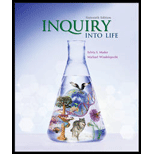
Inquiry Into Life (16th Edition)
16th Edition
ISBN: 9781260231700
Author: Sylvia S. Mader, Michael Windelspecht
Publisher: McGraw Hill Education
expand_more
expand_more
format_list_bulleted
Textbook Question
Chapter 23.3, Problem 1QTC
What would be the potential consequences if one of the genes involved in a multiple gene interaction were to develop an error?
Expert Solution & Answer
Want to see the full answer?
Check out a sample textbook solution
Students have asked these similar questions
Briefly state the physical meaning of the electrocapillary equation (Lippman equation).
Explain in a small summary how:
What genetic information can be obtained from a Punnet square? What genetic information cannot be determined from a Punnet square?
Why might a Punnet Square be beneficial to understanding genetics/inheritance?
In a small summary write down:
Chapter 23 Solutions
Inquiry Into Life (16th Edition)
Ch. 23.1 - Describe how Mendel's law of segregation and law...Ch. 23.1 - Define the term allele, and explain what it means...Ch. 23.1 - Contrast genotype and phenotype, and use...Ch. 23.1 - Predict outcome ratios and probabilities for...Ch. 23.1 - Prob. 1QTCCh. 23.1 - 2. Decide the reasons listed in the feature, what...Ch. 23.1 - Prob. 3QTCCh. 23.1 - Distinguish between the terms genotype and...Ch. 23.1 - Explain the purpose of testcross.Ch. 23.1 - Prob. 3CYP
Ch. 23.1 - Describe the types of process that result in a 3:1...Ch. 23.2 - Recognize autosomal dominant and autosomal...Ch. 23.2 - Analyze pedigree to determine the probability of a...Ch. 23.2 - Describe the characteristics of a Pedigree for an...Ch. 23.2 - Prob. 2CYPCh. 23.3 - Prob. 1LOCh. 23.3 - Prob. 2LOCh. 23.3 - Describe polygenic inheritance.Ch. 23.3 - What would be the potential consequences if one of...Ch. 23.3 - Prob. 2QTCCh. 23.3 - Prob. 1CYPCh. 23.3 - Prob. 2CYPCh. 23.4 - Prob. 1LOCh. 23.4 - Understand how scientists determine the effect of...Ch. 23.4 - Prob. 1CYPCh. 23.4 - Prob. 2CYPCh. 23 - Prob. C2BYBCh. 23 - Prob. S5.4BYBCh. 23 - Prob. S5.6BYBCh. 23 - The law of segregation states all of the following...Ch. 23 - Prob. 2ACh. 23 - Prob. 3ACh. 23 - Prob. 4ACh. 23 - Prob. 5ACh. 23 - Prob. 6ACh. 23 - Which of the following does not have an autosomal...Ch. 23 - 8. Which of the following does not describe the...Ch. 23 - Prob. 9ACh. 23 - Prob. 10ACh. 23 - Prob. 11ACh. 23 - Prob. 12ACh. 23 - Prob. 1TCCh. 23 - How would you determine whether a disease in...Ch. 23 - Prob. 3TC
Knowledge Booster
Learn more about
Need a deep-dive on the concept behind this application? Look no further. Learn more about this topic, biology and related others by exploring similar questions and additional content below.Similar questions
- Not part of a graded assignment, from a past midtermarrow_forwardNoggin mutation: The mouse, one of the phenotypic consequences of Noggin mutationis mispatterning of the spinal cord, in the posterior region of the mouse embryo, suchthat in the hindlimb region the more ventral fates are lost, and the dorsal Pax3 domain isexpanded. (this experiment is not in the lectures).a. Hypothesis for why: What would be your hypothesis for why the ventral fatesare lost and dorsal fates expanded? Include in your answer the words notochord,BMP, SHH and either (or both of) surface ectoderm or lateral plate mesodermarrow_forwardNot part of a graded assignment, from a past midtermarrow_forward
- Explain in a flowcharts organazing the words down below: genetics Chromosomes Inheritance DNA & Genes Mutations Proteinsarrow_forwardplease helparrow_forwardWhat does the heavy dark line along collecting duct tell us about water reabsorption in this individual at this time? What does the heavy dark line along collecting duct tell us about ADH secretion in this individual at this time?arrow_forward
arrow_back_ios
SEE MORE QUESTIONS
arrow_forward_ios
Recommended textbooks for you
- Case Studies In Health Information ManagementBiologyISBN:9781337676908Author:SCHNERINGPublisher:CengageEssentials Health Info Management Principles/Prac...Health & NutritionISBN:9780357191651Author:BowiePublisher:Cengage
 Human Heredity: Principles and Issues (MindTap Co...BiologyISBN:9781305251052Author:Michael CummingsPublisher:Cengage Learning
Human Heredity: Principles and Issues (MindTap Co...BiologyISBN:9781305251052Author:Michael CummingsPublisher:Cengage Learning  Biology (MindTap Course List)BiologyISBN:9781337392938Author:Eldra Solomon, Charles Martin, Diana W. Martin, Linda R. BergPublisher:Cengage Learning
Biology (MindTap Course List)BiologyISBN:9781337392938Author:Eldra Solomon, Charles Martin, Diana W. Martin, Linda R. BergPublisher:Cengage Learning Principles Of Radiographic Imaging: An Art And A ...Health & NutritionISBN:9781337711067Author:Richard R. Carlton, Arlene M. Adler, Vesna BalacPublisher:Cengage Learning
Principles Of Radiographic Imaging: An Art And A ...Health & NutritionISBN:9781337711067Author:Richard R. Carlton, Arlene M. Adler, Vesna BalacPublisher:Cengage Learning Human Biology (MindTap Course List)BiologyISBN:9781305112100Author:Cecie Starr, Beverly McMillanPublisher:Cengage Learning
Human Biology (MindTap Course List)BiologyISBN:9781305112100Author:Cecie Starr, Beverly McMillanPublisher:Cengage Learning

Case Studies In Health Information Management
Biology
ISBN:9781337676908
Author:SCHNERING
Publisher:Cengage

Essentials Health Info Management Principles/Prac...
Health & Nutrition
ISBN:9780357191651
Author:Bowie
Publisher:Cengage

Human Heredity: Principles and Issues (MindTap Co...
Biology
ISBN:9781305251052
Author:Michael Cummings
Publisher:Cengage Learning

Biology (MindTap Course List)
Biology
ISBN:9781337392938
Author:Eldra Solomon, Charles Martin, Diana W. Martin, Linda R. Berg
Publisher:Cengage Learning

Principles Of Radiographic Imaging: An Art And A ...
Health & Nutrition
ISBN:9781337711067
Author:Richard R. Carlton, Arlene M. Adler, Vesna Balac
Publisher:Cengage Learning

Human Biology (MindTap Course List)
Biology
ISBN:9781305112100
Author:Cecie Starr, Beverly McMillan
Publisher:Cengage Learning
Serology 101: Testing for IgG and IgM antibodies; Author: Beckman Coulter Dx;https://www.youtube.com/watch?v=LtqKB-qpJrs;License: Standard youtube license